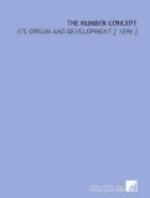In its structure the quinary is the simplest, the most primitive, of the natural systems. Its base is almost always expressed by a word meaning “hand,” or by some equivalent circumlocution, and its digital origin is usually traced without difficulty. A consistent formation would require the expression of 10 by some phrase meaning “two fives,” 15 by “three fives,” etc. Such a scale is the one obtained from the Betoya language, already mentioned in Chapter III., where the formation of the numerals is purely quinary, as the following indicate:[227]
5. teente = 1 hand.
10. cayaente, or caya huena = 2 hands.
15. toazumba-ente = 3 hands.
20. caesa-ente = 4 hands.
The same formation appears, with greater or less distinctness, in many of the quinary scales already quoted, and in many more of which mention might be made. Collecting the significant numerals from a few such scales, and tabulating them for the sake of convenience of comparison, we see this point clearly illustrated by the following:
TAMANAC.
5. amnaitone = 1 hand.
10. amna atse ponare = 2 hands.
ARAWAK, GUIANA.
5. abba tekkabe = 1 hand.
10. biamantekkabe = 2 hands.
JIVIRO.
5. alacoetegladu = 1 hand.
10. catoegladu = 2 hands.
NIAM NIAM
5. biswe
10. bauwe = 2d 5.
NENGONES
5. se dono = the end (of
the fingers of 1 hand).
10. rewe tubenine = 2 series (of fingers).
SESAKE.[228]
5. lima = hand.
10. dua lima = 2 hands.
AMBRYM.[229]
5. lim = hand.
10. ra-lim = 2 hands.
PAMA.[229]
5. e-lime = hand.
10. ha-lua-lim = the 2 hands.
DINKA.[230]
5. wdyets.
10. wtyer, or wtyar = 5 x 2.
BARI
5. kanat
10. puoek = 5 + 5?
KANURI
5. ugu.
10. megu = 2 x 5.
RIO NORTE AND SAN ANTONIO.[231]
5. juyopamauj.
10. juyopamauj ajte = 5 x 2.
API.[232]
5. lima.
10. lua-lima = 2 x 5.
ERROMANGO
5. suku-rim.
10. nduru-lim = 2 x 5.
TLINGIT, BRITISH COLUMBIA.[233]
5. kedjin (from djin = hand).
10. djinkat = both hands?
Thus far the quinary formation is simple and regular; and in view of the evidence with which these and similar illustrations furnish us, it is most surprising to find an eminent authority making the unequivocal statement that the number 10 is nowhere expressed by 2 fives[234]—that all tribes which begin their count on a quinary base express 10 by a simple word. It is a fact, as will be fully illustrated in the following pages, that quinary number systems, when extended, usually merge




